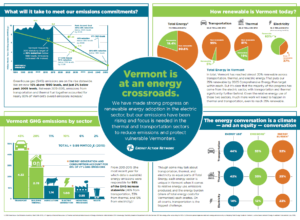2018 Annual Progress Report
Highlights from the 2018 Annual Progress Report
The report shines a spotlight on how meeting Vermont’s energy and emissions commitments will require state action far beyond what is already occurring, with major benefits awaiting Vermonters and the state economy. Some key takeaways:
- Vermont’s total energy use—across transportation, thermal, and electric use—stands at 19% renewable as of 2018. Vermont’s Comprehensive Energy Plan established 25% renewable as the first milestone for the State’s total energy use by 2025.
- Greenhouse gas (GHG) emissions have been on the rise: climate pollution from Vermont is now 16% higher than it was in 1990, primarily due to increased use of fossil fuels for how we get around and heat our homes and buildings. The Paris Climate Agreement as committed to by Governor Scott requires a 26-28% reduction in emissions below 2005 levels. Vermont was only 2% below 2005 levels as of the latest data, in 2015.
- The transportation and thermal energy sectors together make up 86% of Vermont’s energy use and 71% of Vermont’s emissions.
- EAN modeled the scale of energy transformation necessary to meet the 2025 targets required by the Paris Climate Agreement and Vermont’s Comprehensive Energy Plan, which include:
- Adding 90,000 electric vehicles by 2025
- Adding 90,000 heat pump systems by 2025
- Adding 25,000 advanced wood heat systems by 2025
- Weatherizing an additional 90,000 homes by 2025
- Increasing the non-EV vehicle efficiency by 5% by 2025
- Doubling transit and shared mobility to reduce the number of single occupancy work commutes by half
- Adding 90,000 heat pump water heaters
- Continuing to invest in renewable electricity: adding 200 MW of wind, 500 MW of solar, and 15 MW of farm and landfill methane systems
- 20% additional reduction which may come from non-energy related emissions reduction strategies (e.g. carbon sequestration), new products or technologies, increased efficiencies, and reduction in consumption due to outside influences.
- Vermont has an opportunity to lead the nation in demonstrating how reducing emissions can benefit people in a rural, middle income state.
- Vermont already has almost 19,000 clean energy jobs, the highest share (6%) of employment in clean energy of any state in the country.
- 78 cents of every dollar spent on fossil fuels drains out of Vermont. Efficient and renewable options like weatherization, sustainable wood heat, cold climate heat pumps, and electric vehicles not only provide Vermonters lower and more predictable fuel costs, they also keep up to three times or more of our energy dollars here in state, benefiting all Vermonters.
- The report highlights California, Quebec, and British Columbia as examples Vermont can look to for how to successfully reduce emissions while improving the economy. Each has regulated emissions economy-wide and invested revenue in proven renewable alternatives that have brought emissions back below 1990 levels and also helped contribute to impressive economic growth.
Read the full 2018 Annual Progress Report
This year’s report came with a full-color poster of some of the key graphics. Download your copy!


